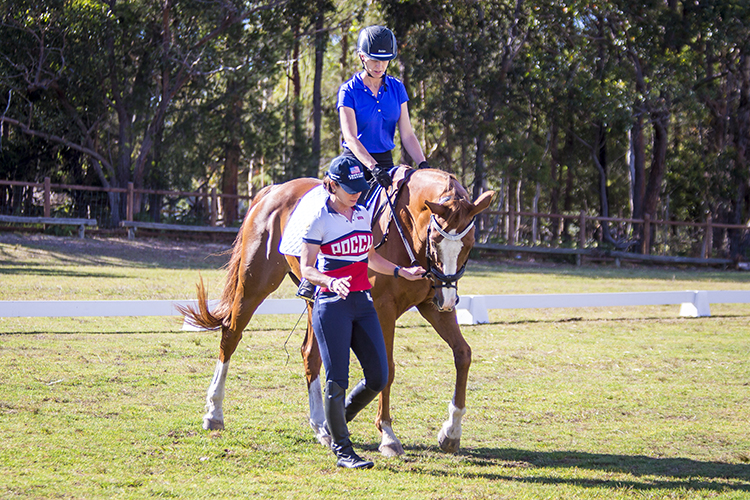 Rebecca Ashton sits in on a clinic with the German Olympian. Rebecca also took the photos…
Rebecca Ashton sits in on a clinic with the German Olympian. Rebecca also took the photos…
It was an early start for eventing legend Bettina Hoy with her clinic at Northside Riding Club on Sydney’s northshore. “I miss that sound!” she exclaimed from the arena, as the kookaburras were cackling away, welcoming what would be a blisteringly hot day.
Bettina honed in immediately on position with most of the riders, including first student, Ragen Palmer, “Let’s look at your seat. Don’t squeeze with your knee or you’ll stick your bottom out. Relax your legs from your hips and pull your belly button in. From your posture being like that, you can push the horse into the bridle.
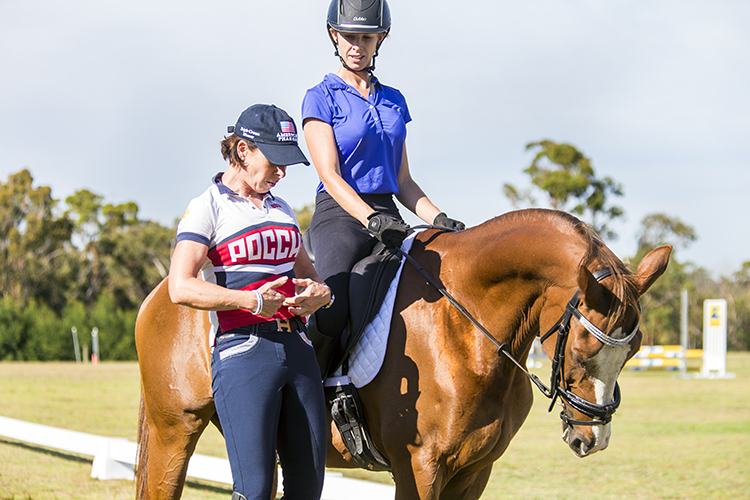
Bettina and Ragen – “Relax your legs from your hips and pull your belly button in.”
“So, I should be doing something the whole time?” Ragen looked for clarification.
“Yes…the whole time. But it will be conscious for you, for me a lot of it is unconscious.”
“You have to go through the stages. At the moment, you have to react, but really If you have to react, it’s too late. You’ll develop a feel to which aids he’s ignoring and you’ll pay more attention to that until it becomes unconscious.”
Ragen then spoke to her horse, Joey, “There’s a new policeman in town,” before Bettina joked, “And she’s German!”
The rest of the lesson focused on Ragen developing better feel, and putting her body in a position where this was possible, as well as knowing which muscles to relax and which ones to use. Bettina’s English is not only perfect, but her analogies make her a wonderful teacher, “To get the correct feeling on the rein, take the rein slowly followed by a quick release. You have a sponge in your hand and you let the last little bit of water out. It’s not your whole arm, just your hand. Elbows relaxed. You cannot communicate with the horse with straight elbows. You block him and then he’ll slow down. Don’t lock your elbows, don’t lock the shoulders. Feel your shirt in front of the rib cage and keep talking to the horse the whole time. Your posture needs to keep your hands quiet while your hands need to be completely independent. When he starts to soften a little bit, keep pushing with your legs. Every now and then, lower your eyes and look at the horse’s ears because from there you can see what the horse is doing and you can also check on what your hand is doing.”
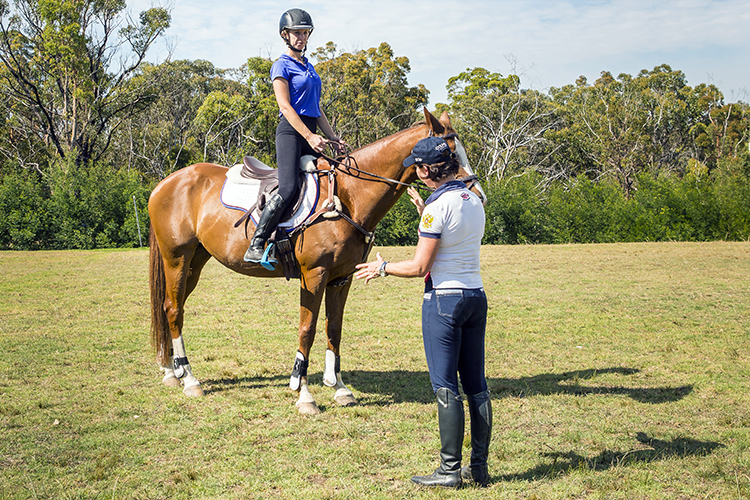 Bettina and Ragen
Bettina and Ragen
Bettina also drove home the importance of consistency. The work has to become a habit for both horse and rider. “There has to be one principle. Everyday it has to be correct. When I warm up for a dressage test, especially the young horses, I warm up on the lines I have to ride in the test. How many people do you see doing circle after circle? I don’t know how many circles I’ve seen in the last few days! Yes, you have to do circles, but the horse also needs to be able to go on straight lines. After the second corner, they should know something is coming… is she going to make me go across the diagonal, or on a circle line, or into a shoulder in? They just know something will happen and are ready for you.”
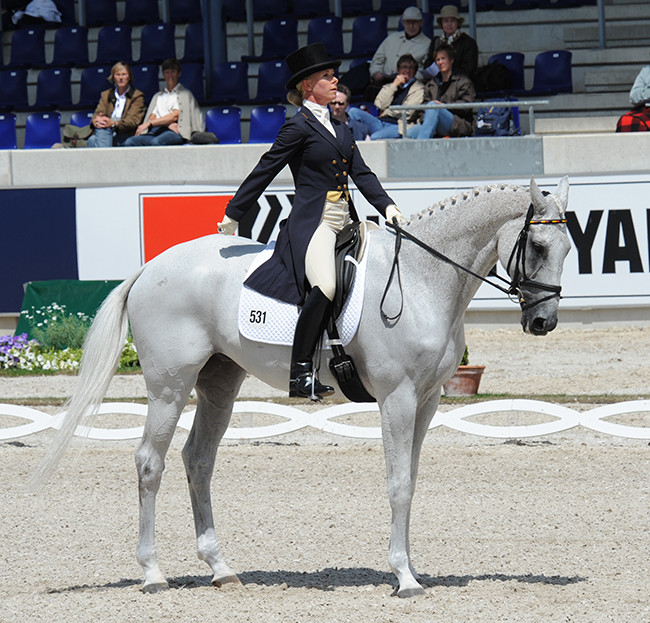
A perfect 10 for a halt for Bettina and Ringwood Cockatoo from Christoph Hess
The German is also a big advocate for copy learning. It’s important to watch lots of top riders and watch lots of videos. Pick the riders you want to emulate and really analyse what they do. Always have that vision in your mind. “I want to look like Marcus Ehning when I showjump. I think he’s the greatest in the world. His position, the way he communicates with the horse and he’s worked with many difficult horses, he’s always in balance. Michi Jung copies him too. He’s had lessons with Marcus.”
Read on below:
By the end of the session, Ragen had her horse rounder and softer as she could keep her posture intact with soft elbows and quiet hands. “It all comes down to you having your body under control,” concluded Bettina.
Next it was time for some show jumping with three riders: Becky Soans, Jose Diacono and Ragen did a quick costume change out of her dressage saddle and into jumping tack. Again the lesson began with rider position, making sure everyone had a good posture and correct hand and leg position on a walk circle. When Jose’s big black horse tripped, Bettina explained why, “You were pulling a bit so he was focused on the front end instead of being in his own balance.”
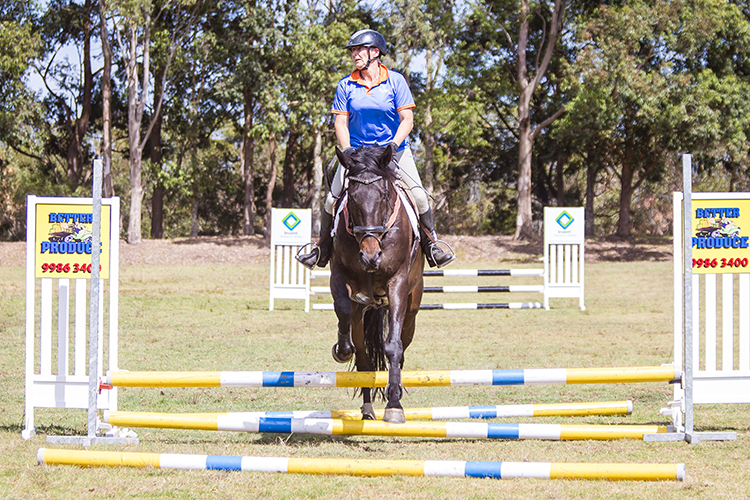
Jose and Max
Then it was straight up into the two-point seat, accompanied by reminders to stay tall and not to rest the hands. “Whatever muscles are burning are the ones you need to train.” Trot poles were added to the equation and Bettina explained why she was putting the riders through this ‘torture.’ “Everyone thinks jumping lessons are about going over jumps, but it’s about being in a position to allow the horse to jump well.” Bettina wanted the riders to feel the balance needed to allow the horses to jump well.
As Ragen’s stirrups were shortened to help her balance, there came a warning against the flash, colourful stirrups that have become popular these days, “I think they tend to be too light. Heavy stirrups drop into the right place if you lose them. I know a lot of top riders use the light ones, but those riders can ride in anything.”
The difficulty was increased when riders had to canter over the poles and it was again a focus on rider position and its importance in keeping time faults at bay. “In order to lose as little time as possible cross country, I want my horse to react to my position. I come back in my position before I jump and if they’re well trained, they’ll come back with me without me losing too much time. Then I leave the fence in a two-point seat to move away quickly. Chris Bartle always says we have five different seats: dressage at one end of the scale, racing at the other, and three in between.”
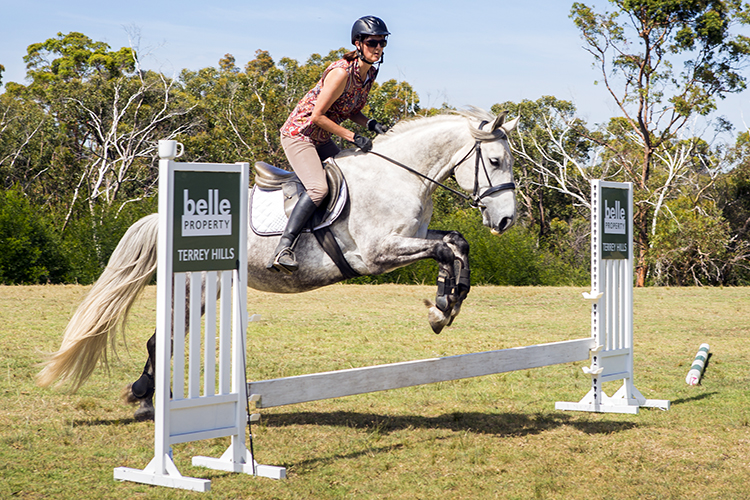
Becky and Malachai
The riders were instructed to sit in the saddle into the jump and then resume the two-point seat again afterwards. When there were problems with the rhythm, Bettina had the riders count out loud. “What happened then?” she asked rhetorically. “You didn’t miss a distance because counting out loud made you breathe! In the start box, to get into my rhythm quickly, I count the canter strides quietly, more in beats than numbers. Finding the rhythm and not interfering so much lets me take control quicker because I’m not hanging on the mouth. Chris (Bartle) always says we’re in control of three things: balance, the line you ride and the speed (which comes with rhythm). Riding the rhythm is riding the speed which is the most comfortable. Never jump without good rhythm.”
As the riders began tackling some small jumps, Jose’s horse Max was taking over a bit, so Bettina jumped on to rebalance him with her deep seat, good balance, soft knees and calves on with a quiet hand. “Notice that I’m not pulling. I’m taking and giving,” she highlighted. “If you squeeze with your knee, the horse gets faster. Use your core. Take and give. Don’t forget the give part.”
Correct posture also included the head, and once again Bettina referred back to her jumping hero, “Youtube Marcus Ehning Madrid 2016. Look how soon he turns his head over a jump. The horse is almost turning mid air! Look where you’re going and the horse then has an idea where you’re going. Then they usually land on the correct lead. I almost look as I’m taking off. I look quite early.”
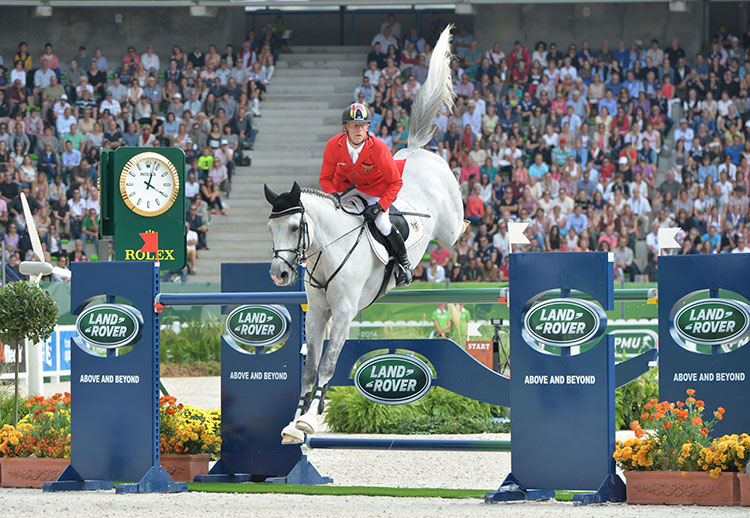
Marcus Ehning with Cornado, looking where they are headed at the WEG in Normandy
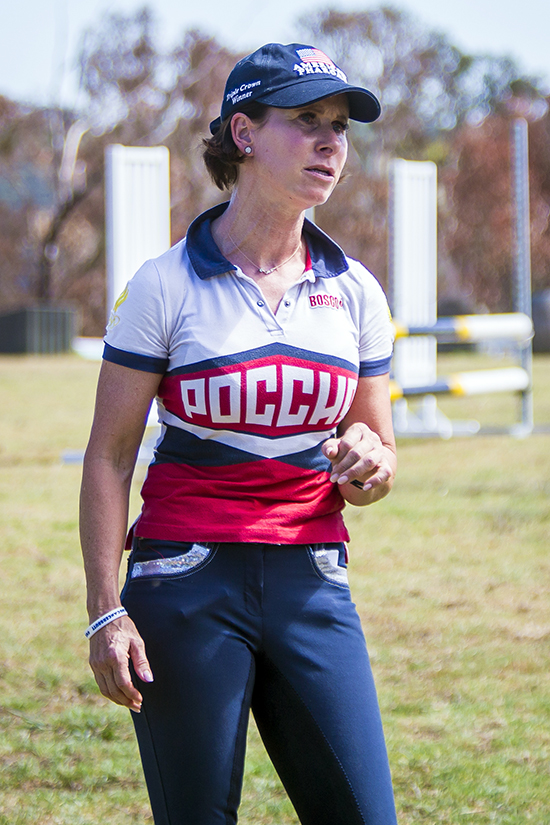
It was back to the dressage arena and even a broken finger wasn’t going to keep clinic organiser Angela Shacklady away. Position was discussed and then Bettina concentrated on the use of the aids. “They need to be short and sharp,” she encouraged, “He needs to be a little bit more in front of the leg. Also be conscious about the inside leg into outside contact.” Bettina’s exercise of choice here was leg yielding to help Angela understand better the diagonal aids and also to help (the horse) remain in balance.”
The balance was then worked on at the canter, accompanied by some tips, “The canter gives you a little bit more impulsion, a little bit more umph for the trot. If you’re on a blood horse, you have to remind them to sit back a little more. They’re different. Half halt on the outside rein every few strides so that he stays balanced and not into the inside shoulder.
“Now you’ve built the connection from back to front in the canter, don’t then let it all fall apart when you trot again. Keep the connection.” Cosmo was throwing his head a little in the downward transitions so Bettina helped out once again, “With the outside hand, ask him to stay with you into the canter and follow the bend with the inside hand. Inside hand down and to the side. You have to do that a few times until he understands.”
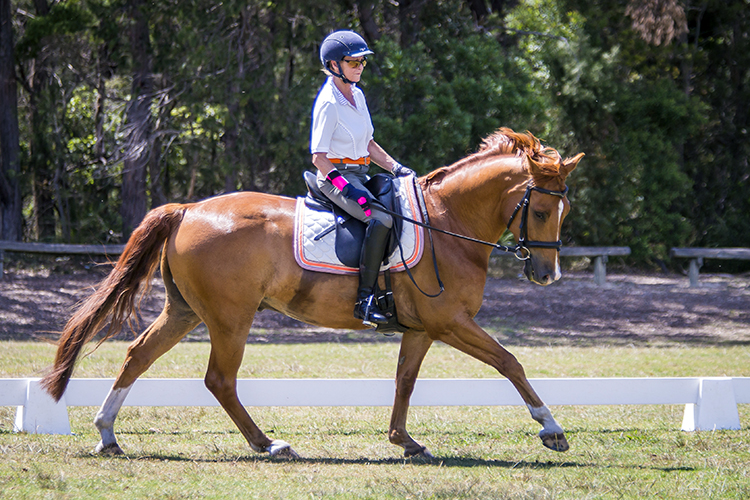
Angela and Cosmo
Like the riders before, Becky Soans had her position aligned and corrected before she got too far into the lesson on Malachai. “Left hand stays left of the neck, right hand stays to the right. The more you move your elbow away, the harder it is to keep your body balanced and aligned. The distance between your ears and shoulders needs to be as big as possible.” Bettina placed her hand on Becky’s lower back. “Push into my hand. That’s the strength you need in your core. You need the good posture so you can communicate with your horse. Every time something feels not quite right, the first thing I do is engage my core. Often then everything else falls into place.”
“The outside shoulder back helps to keep him to the outside so he doesn’t fall against your inside leg. Elbows stay bent, even the outside and even though you’re on the bend. The outside rein slows him down. The strength is in the fist, keeping your fingers closed and use your core, rather than your arms.”
Then it was into some trot leg yield from the centreline across to the long side and Bettina brought awareness to the importance of detail. “You didn’t ride the corner so how can you get down the centreline? Riding correct lines is half the marks you get in the dressage test. There are no shortcuts in training a horse. So, getting into the corner and getting onto a really good centreline is very important. Use the space you’ve got. As you come across in the leg yield, keep pushing. Don’t give up so easily. Force yourself, not your horse. Make yourself be accurate and correct. We are women… we can multi task!!”
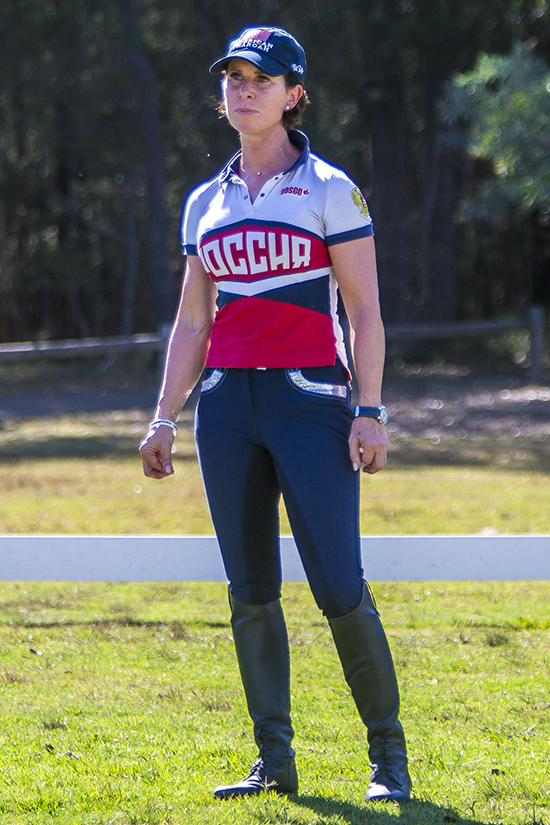
Bettina verbally rode the leg yield left to right along with Becky, “Every second step or so, position the shoulder; constantly position it. Say woo, thank you, ring finger and core. Keep the front end over to the left with the right rein. So you have to keep your outside shoulder more back. He wants to do it right, you are just telling him the wrong messages with your posture.”
Next it was on to the canter and Bettina wanted Becky to sit deeper in the saddle, “Sit on your bum. If you do that you’re part of the movement. If you squeeze with your thighs you can’t sit. Stay soft in your hips, draw yourself into the saddle and keep the calf just against his rib cage.”
Bettina also had some tips for working on rider position at home. She advised Becky to be lunged on the horse in side reins, but with no reins or stirrups, to work solely on posture without worrying about the horse. This could include doing some cross exercises such as right hand to left foot which helps to centre the rider. Stability balls at the gym are also a good idea. Tipping on right seat bone then left while asking yourself, “Are you using upper body or just seat bones and hips?”
The last rider of the day was young Olivia Fruin on little Buzby. The pony had a tendency to curl his neck up. Bettina again went right to rider position and explained why pushing the horse from behind and catching with half halts to round the back would create a better frame in the pony.
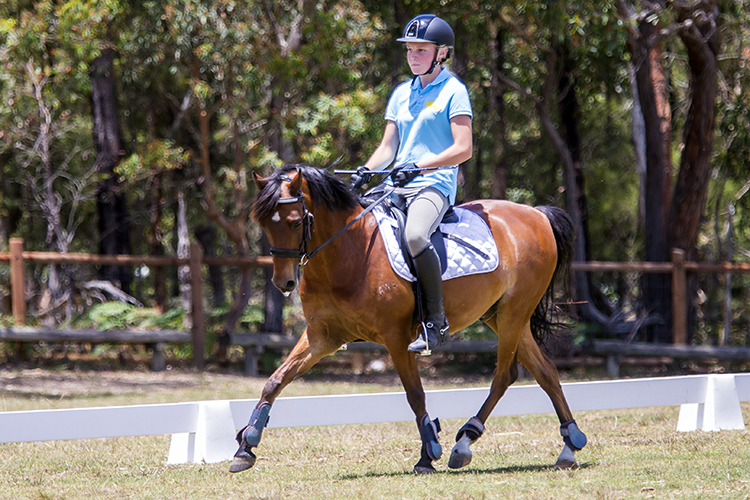
Olivia Fruin and Buzby
“So, sit tall with the shoulders and sit deep with your seat. Have the weight in the ball of your foot in the stirrup and arms by your side. Just because you’re sitting on a smaller pony, don’t become smaller yourself. Sit tall. When you ride a test, you have to enter the arena and say to the judge via your posture, ‘Here I am and I’m going to show you how good we are!’ Don’t lean forward because then you pull on the reins again. If something goes wrong, if something happens, the first thing is to bring your belly button in and engage your core. Push your hands towards the horse’s mouth. Don’t pull back. Push with your leg and keep your hands quiet. Feel like you have two sticks in your hands, not reins. Push them forward.”
Bettina helped out by finding a short crop to put under Olivia’s thumbs. There was no way to cheat now! The change in the horse was almost immediate. “Now you have him into the bridle. He’s a beautiful mover!”
Leg yield was next and Bettina corrected the right to left, “Left says wait and right says go over. You slow the left side down. That way you keep him parallel to the track. Yes move him over from the right leg. He needs to yield to it. You have to stay straight though. Don’t you flex, you look straight. Make sure you don’t use your rein at the same time as your leg. Remind with your hand then relax; remind, relax.”
The session finished with some stretchy trot but it was important that Olivia didn’t throw away the contact completely, “Don’t give up your contact and lose everything you just achieved! Slowly let him longer and keep playing and communicating with him. This is your cool down phase and also how you want to start.”
Bettina is a clear, calm and patient communicator. It’s obvious how much she enjoys her teaching and helping her students understand their horses better. We hope those kookaburras might be calling her back to our shores very soon.
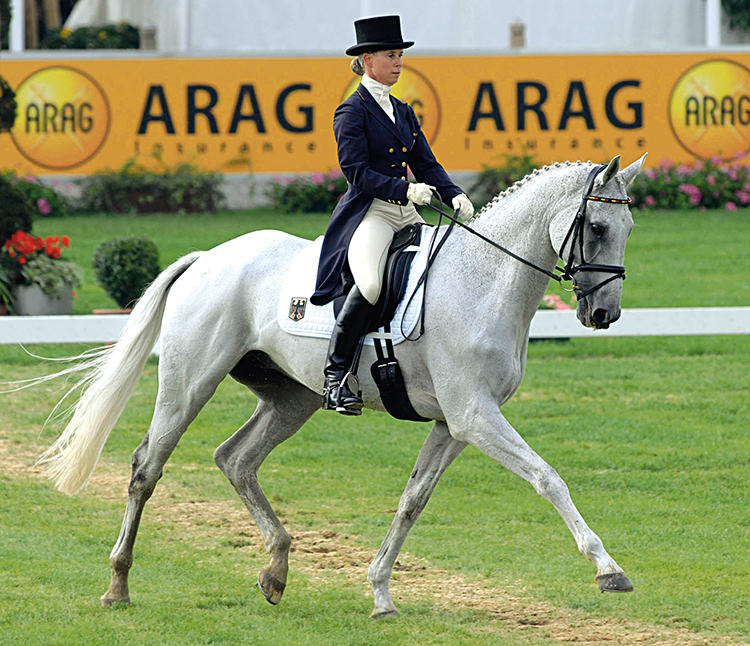
Bettina Hoy and Ringwood Cockatoo – demonstrating what she teaches, “sit tall with the shoulders and sit deep with your seat. Have the weight in the ball of your foot in the stirrup and arms by your side” / Photo: Kit Houghton
Earlier today you were talking about “copy training”. Can you expand a bit on that?
What you need to have as a riders a picture in your mind of who you want to look like. You obviously want to pick a really good rider! It does help to watch videos and you also want to get yourself videoed because a lot of people don’t realise what they are doing, especially if you don’t have an arena with mirrors. Then you can compare the two. As much as you try to follow instructions, you need to have body awareness. For body awareness, certain classes are really good. What I explained to Becky, exercises on the ball, where you sit on the ball and you do it in front of a mirror and you practice the effect of moving your hips without moving your shoulders. Feel the effect it has on the ball which will be similar to the horse. Then you can control yourself better; you can isolate different parts of the body, keep your hands still. I think that’s where pilates is good because the better your core, the more independent other parts of your body can be. That’s the thing the good riders have.
What do you do for fitness?
I go to the gym four times a week and do a lot of spinning and rowing because they use similar muscles. Spinning, if you do out of the saddle and in the saddle, it’s applying the same muscles as you ride. Rowing is similar, if you do it correctly, you’re using your core and you’re using your legs and hands. Although you don’t want to pull with your hand like that, still you’re getting the strength in the right place in the upper body. I also do cyber courses at a place called McFit. They are 24hr gyms all over Germany which means I can go whenever I like and I can pick whatever class I like. A lot of the sessions are about balance too and I like those classes as they make me realise how one sided my muscles are because I use the same muscles all the time and if I have to balance myself properly, like some yoga poses standing on one leg, I struggle. I do a lot of core exercises, not so much weights because you need to train your stabilising muscles, not your mobilising muscles. That’s where pilates is actually good. In England we had a pilates coach and private lessons and I’ve also had some yoga lessons privately. They really helped me. I’m not into the relaxing sessions so much because I fall asleep. I need to have action! I find the fitter I am, the better I cope with any stress situations. I’ve also seen, doing a lot of teaching all over the world, people expect their horses to be fit and they’re not fit themselves. I do believe the fitter you are, the better you can assist your horse or help if you get into a bad situation when the horse gets tired. Ultimately, it keeps us enjoying the sport more and it keeps us safer.
Who have been the biggest influences throughout life?
I’ve had a lot of amazing instructors but my biggest influence is without doubt my Dad. Also, in regards to my dressage, Klaus Balkenhol because Klaus is a family friend so there was a connection already before the horses even came into it. Now Sebastian Heinze is my dressage coach and especially in the last 18 months, he’s had a really big influence. Cross country is really Christopher Bartle. He’s been amazing, so motivating, very positive and he’s helped the German riders a lot to ride in balance. He’s got expressions like, “You need to learn to get into the ‘Oh shit’ position!
Originally when I first moved to England, Andrew (Hoy, Bettina’s ex husband) obviously had a big influence on my cross country riding and how I get the horses fit. My strong part had always been dressage and show jumping because that’s where I came from, but Andrew certainly taught me a lot about getting this natural feel for the cross country; riding with shorter stirrups to get my balance better, things like that.
next Bettina discusses coaches
What makes good coach?
You need to be technically very correct and persistent but I also I think you need to have a lot of empathy. I know for myself, I go skiing and I haven’t skied for ages and the instructor says do this and do that and I think, “I hear what you’re saying, but my body just does not want to do it! I’m really trying!” It’s having the empathy to realise that people have to leave their comfort zone to change and that is not easy. If you’ve done something for however many years and then to change it, that is very difficult. It’s really important to understand that.
Also, I get really upset if someone gets upset with their horse. Most of the bad things, we’ve taught the horse. Sometimes you hear, “Well, he’s doing it on purpose to annoy me.” Well no horse does that. They react to what we do. Sure, some horses have had a bad experience and they don’t like their job anymore, but then you need to get a trainer in to teach the horse and you have to get on a horse that hasn’t had a bad experience. You both learn separately to bring the whole thing together once more. If in doubt, you have to blame yourself not the horse. You have to really implant that into people’s brains as a coach. I’m very adamant to teach that.
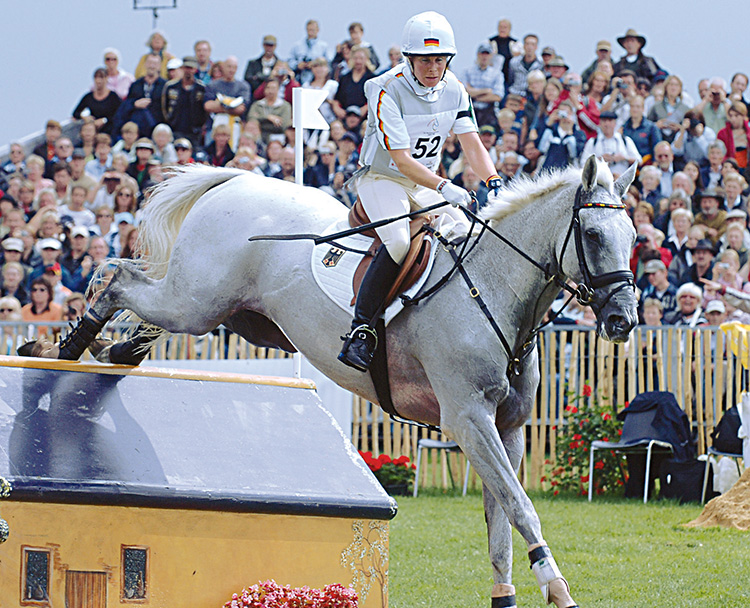
Bettina and Ringwood Cockatoo at Aachen WEG in 2006, running second after the cross country
Chris Bartle is moving back to coach to Brits. What are the effects on the German team?
It’s really very, very sad but we can totally understand where he’s coming from. He’s got a young family, he wants to be closer to home, he is British and to be honest, he’s achieved everything he could possibly achieve with us. He’s won so many medals with us, why keep going? Now was the perfect time because Yogi has gone into retirement. I can totally understand.
As a coach, he was very clever because he basically went along with our strengths and worked on our weaknesses. He never tried to completely change what we were doing. The one thing people perhaps forget a little bit, as Germans we’re used to being taught because we have instruction from day one. I think Germans are possibly easier to teach than other nationalities and we have the benefit of good instructors and a good training system, so we all have a very good base which is much easier to build on than if you’ve been doing something wrong for years. But I can say, Chris really picked me up and gave my confidence back when I needed it. He made me trust my knowledge and myself and I’ll be forever grateful that he did that.
You like to get horses young and build them up. What do you look for?
Basic, correct paces. They need to have a temperament I can work with and they need to have a really good jump. I like to have as much blood as possible. I like to have Thoroughbred on both sides. It’s sometimes a bit difficult to find.
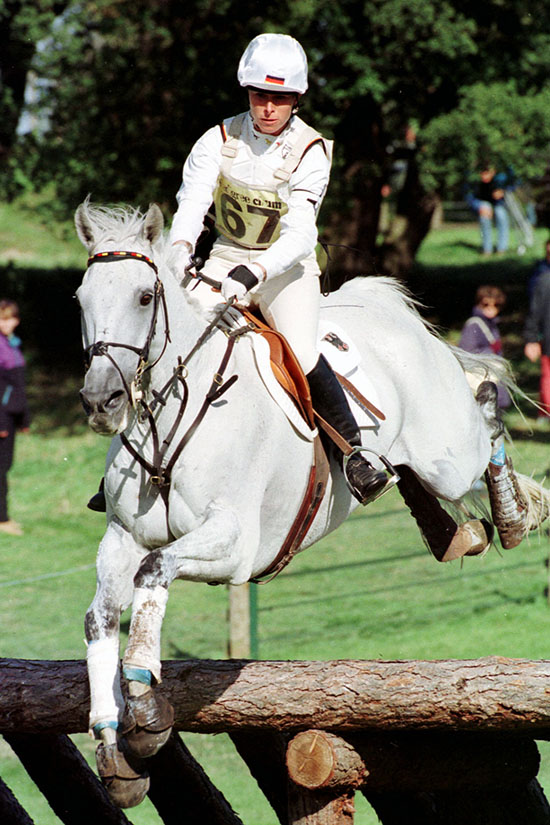
‘I love getting the best out of the horse, training them to the best of their ability.’
Bettina on course with Ringwood Cockatoo
Even with the “newer” structure of eventing with shorter cross country?
If you look at the horses that do really well at the very big events or the really tough events, they are all blood horses. Look at Haras du Pin, look at Jonelle’s horse (Classic Moet), look at Opgun Louvo, look at Rocana, they did really well. Other horses got two thirds around and they couldn’t do it. Rio was a little bit the same. It was hot and they didn’t show jump so well on the last day. So, when the going gets tough, you need very much a blood horse. If it’s flat and not so tough, you can get away with more Warmblood. The less blood you have, the better you have to be as a rider as well because you have to nurse them home, you need to be better balanced and more effective.
Last year you were the first German to win Blenheim. How was that?
Yes that was really exciting! I was the first woman to go to World Championships for Germany, the first woman to go to Olympic Games and win a medal. I’ve done a few firsts!
I’ve got four horses at the moment. I’m actually currently looking for a dressage horse. I’ve done everything at the top, top level in eventing. I’ve competed to Inter 1 level in dressage so now I’d like to ride Grand Prix and with my great coach Sebastian, I think that would be a nice challenge.
more below
What keeps you motivated?
I just really love it. I love getting the best out of the horse, training them to the best of their ability.
I do have an agreement with Dirk Schrade, he’s one of my best mates, that if I start riding so badly that people say they wished I’d given up two years ago, he will be the one to tell me. I told him I might not talk to him for six months, but I want him to tell me because the last thing I want is for people to be laughing. So as long as I can keep riding like I am now, I’ll keep going at this level because I really, really love it.
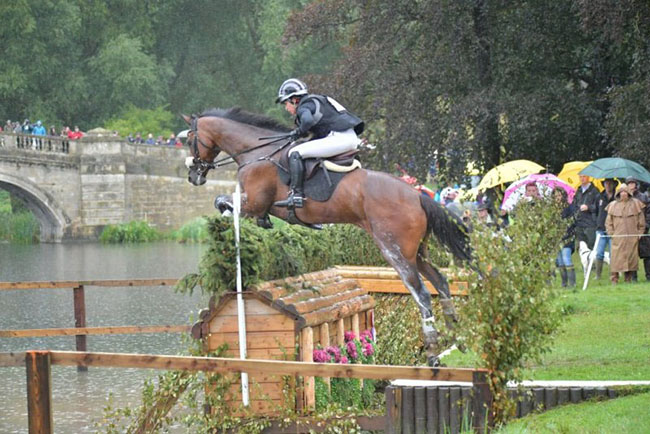
Bettina and Seigneur Medicott winning at Blenheim last year / Photo: Matt Nuttall
Someone was asking me the other day what I thought Designer was worth. I said a figure and he said, “Well why don’t you sell him?” I said, “Why would I give up doing what I love doing most?” I mean, what am I going to do with the money? I’d rather give more clinics and work harder. You need to have enough to live and be comfortable. If someone offered me a ridiculous amount, I would have to consider it, but I don’t know if I would be a happier person. What numeric value can you put on happiness? You can’t. There is nothing that replaces happiness and I’m really truly happy doing what I’m doing.
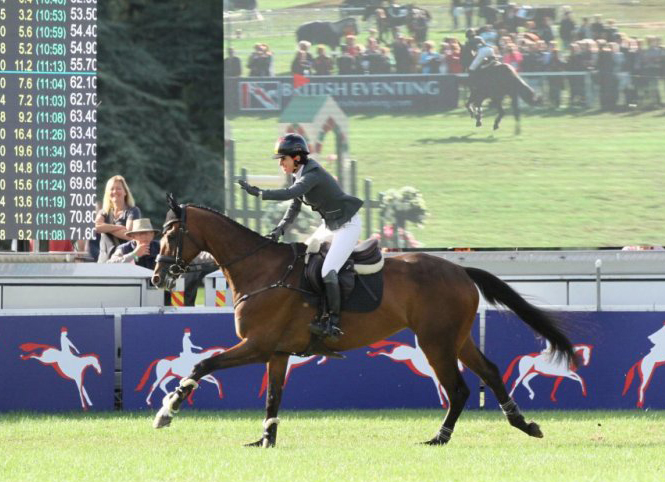

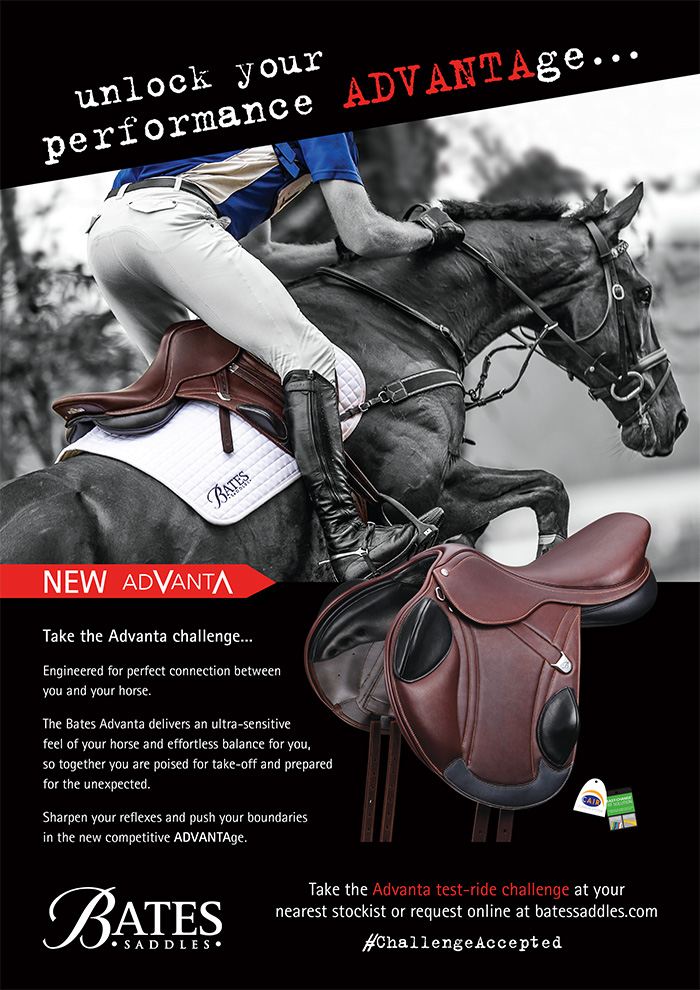
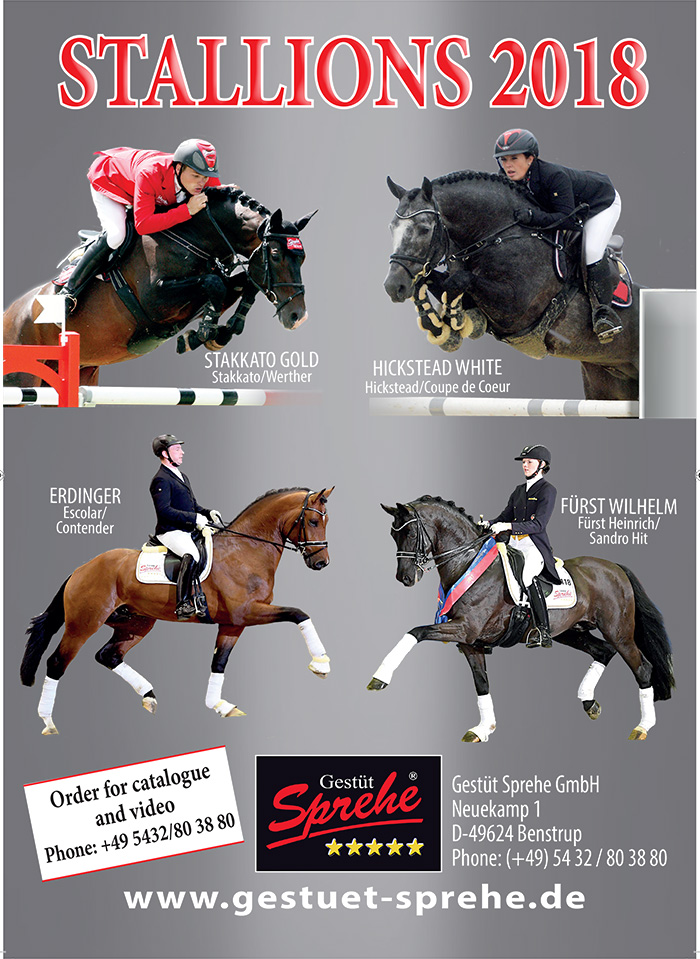
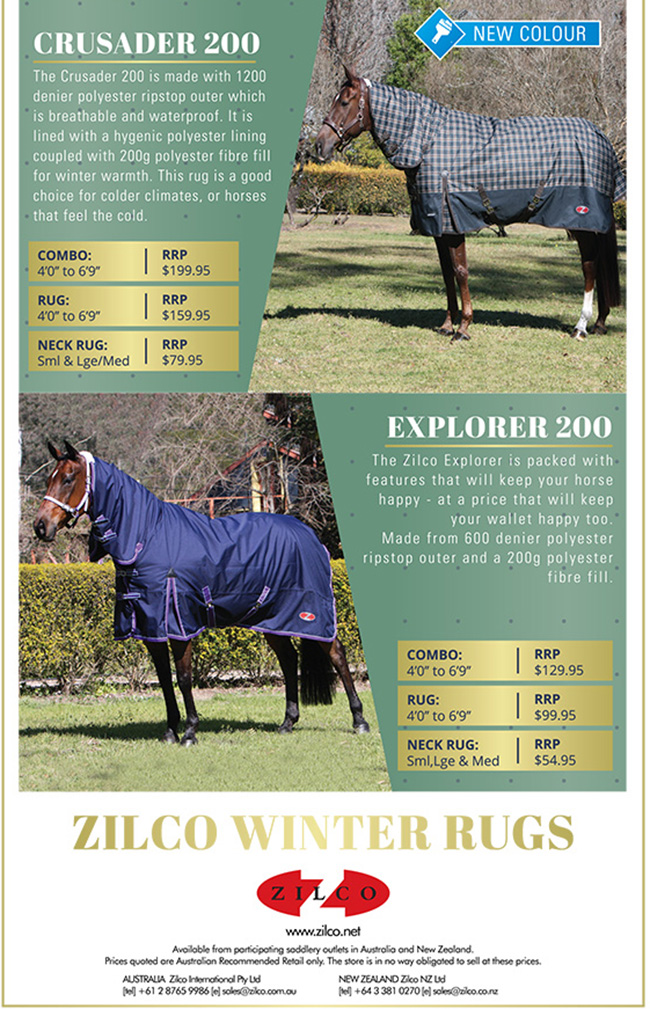
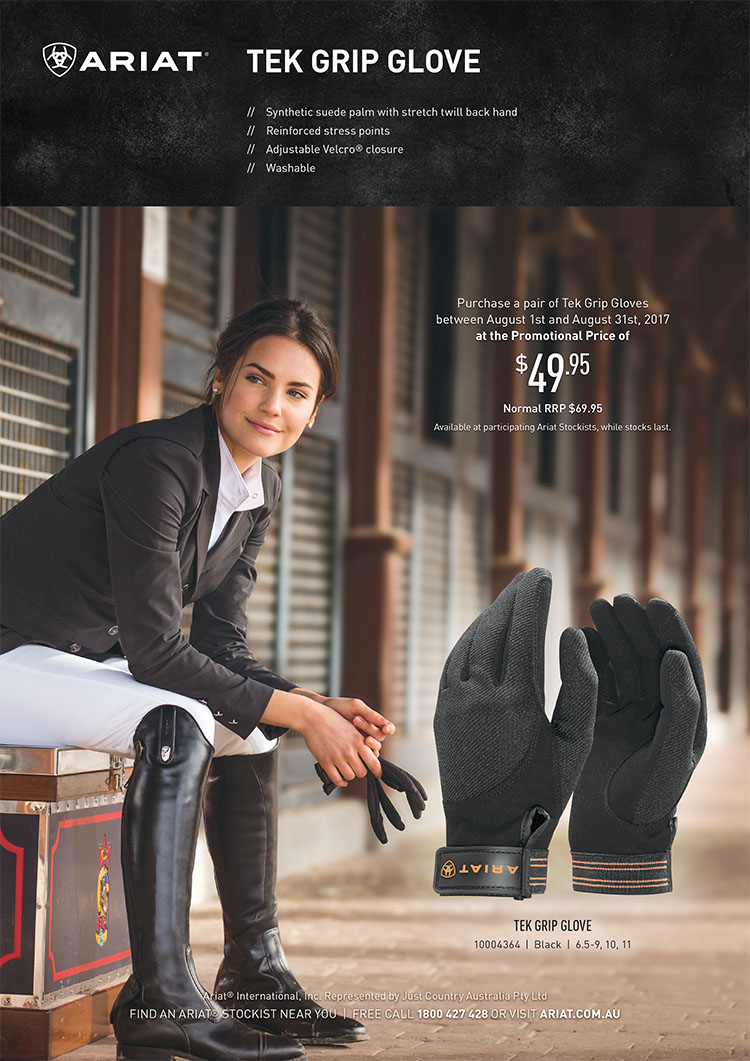
What a lovely article and my daughter Amy was also able to enjoy a wonderful clinic with Bettina at Northside on our young eventer and learned so much great read thanks again it has really helped with the start to this season.